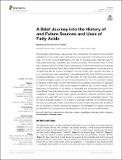Files in this item
A brief journey into the history of, and future sources and uses of fatty acids
Item metadata
| dc.contributor.author | Cerone, Michela | |
| dc.contributor.author | Smith, Terry K | |
| dc.date.accessioned | 2021-08-12T16:31:18Z | |
| dc.date.available | 2021-08-12T16:31:18Z | |
| dc.date.issued | 2021-07-20 | |
| dc.identifier | 274973591 | |
| dc.identifier | 3f9ace02-4ab5-4e62-b47a-d0f0c72b66f6 | |
| dc.identifier | 85111939181 | |
| dc.identifier | 000897884600001 | |
| dc.identifier.citation | Cerone , M & Smith , T K 2021 , ' A brief journey into the history of, and future sources and uses of fatty acids ' , Frontiers in Nutrition , vol. 8 , 570401 . https://doi.org/10.3389/fnut.2021.570401 | en |
| dc.identifier.issn | 2296-861X | |
| dc.identifier.uri | https://hdl.handle.net/10023/23771 | |
| dc.description | Funding: The authors would like to thank the Engineering and Physical Sciences Research Council, University of St. Andrews, and the EPSRC Centre for Doctoral Training in Critical Resource Catalysis (CRITICAT) for financial support (Ph.D. studentship to MC; Grant code: EP/L016419/1). | en |
| dc.description.abstract | Fats and lipids have always had a primarily role in the history of humankind, from the ancient civilisations to the modern and contemporary time, going from domestic and cosmetic uses, to the first medical applications and later to the large scale industrial uses for food, pharmaceutical, cosmetics and biofuel production. Sources and uses of those have changed during time following the development of chemical sciences and industrial technological advances. Plants, fish and animal fats have represented the primary source of lipids and fats for century. Nowadays the use of fatty acid sources has taken a turn: industries are mainly interested in polyunsaturated fatty acids (PUFAs), which have beneficial properties in human health; and also, for high-value fatty acids product for innovative and green production of biofuel and feedstocks. Thus, the constant increase in demand of fatty acids, the fact that marine and vegetable sources are not adequate to meet the high level of fatty acids required worldwide and climate change, have determined the necessity of the search for renewable and sustainable sources for fatty acids. Biotechnological advances and bioengineering have started looking at the genetic modification of algae, bacteria, yeasts, seeds and plants to develop cell-factory able to produce high value fatty acid products in renewable and sustainable manner. This innovative approach applied to FAs industry is a peculiar example of how biotechnology can serve as powerful mean to drive the production of high value fatty acid derivatives on the concept of circular bioeconomy, based on the reutilisation of organic resources for alternative and sustainable productive patterns that are environmentally friendly. | |
| dc.format.extent | 15 | |
| dc.format.extent | 1427002 | |
| dc.language.iso | eng | |
| dc.relation.ispartof | Frontiers in Nutrition | en |
| dc.subject | Cell-factory | en |
| dc.subject | Polyunsaturated fatty acids | en |
| dc.subject | Biofuels | en |
| dc.subject | Biotechnology | en |
| dc.subject | Microalgae | en |
| dc.subject | Plants | en |
| dc.subject | Oleaginous microorganisms | en |
| dc.subject | Sustainable sources | en |
| dc.subject | QR Microbiology | en |
| dc.subject | SDG 3 - Good Health and Well-being | en |
| dc.subject | SDG 7 - Affordable and Clean Energy | en |
| dc.subject | SDG 13 - Climate Action | en |
| dc.subject | SDG 14 - Life Below Water | en |
| dc.subject | MCC | en |
| dc.subject.lcc | QR | en |
| dc.title | A brief journey into the history of, and future sources and uses of fatty acids | en |
| dc.type | Journal item | en |
| dc.contributor.sponsor | EPSRC | en |
| dc.contributor.institution | University of St Andrews. Biomedical Sciences Research Complex | en |
| dc.contributor.institution | University of St Andrews. School of Biology | en |
| dc.identifier.doi | https://doi.org/10.3389/fnut.2021.570401 | |
| dc.description.status | Peer reviewed | en |
| dc.identifier.grantnumber | EP/L016419/1 | en |
This item appears in the following Collection(s)
Items in the St Andrews Research Repository are protected by copyright, with all rights reserved, unless otherwise indicated.

